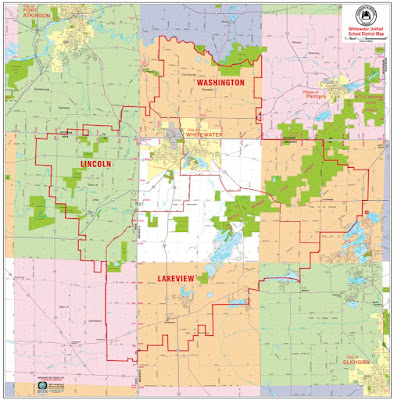On Friday, I asked three questions about the implications of the June recall election, and yesterday I wrote about the first of them (implications for the newly redistricted 43rd Assembly district). Today, I’ll look at what the numbers say about the electorate within the Whitewater Unified School District. A map of the district appears immediately below. Needless to say, it’s significantly smaller than the state assembly district about which I wrote yesterday. Additionally, also unlike the 43rd, the boundaries of the district aren’t changing.

The April Referendum and the June Recall. In April, a referendum on exceeding revenue caps for the WWUSD passed, with a vote of 1,496 to 1,351. That’s roughly a 52-48% margin. Within the boundaries of the district during the recall, Gov. Walker received 4,207 votes to Mayor Barrett’s 3,604. That’s nearly a 54-46% margin for Walker, and a bit better than his statewide percentage.
Support for candidates and for a referendum differs significantly, and one could reasonably contend that the referendum was less ideological than a contest between a Republican and a Democrat in the recall.
(There are, after all, Republicans and Democrats on both sides of many spending issues.) Although it may pain fiscal conservatives to hear as much, they surely know that there are undependable allies among some Republicans (just as they must see that there are dependable ones among some Democrats).
The Different Results. And yet — and yet — one election yields a result that, I think, would have been unlikely with other election’s voters. Why is that? While the presence of university voters in April but not June may play a role, Whitewater’s citywide vote favored both the referendum in April and the Mayor Barrett in June. What’s even more significant, I think, is that there was a far larger overall turnout in June (7,811) as against April (2,847). The electorate was, actually, 2.74 times as large. June’s voters were more numerous, and it’s safe to say, more conservative.
June’s net for Barrett in Whitewater was 528 votes, but the net for Walker everywhere else in the district was over 1,131. Republicans can and did turn out in large numbers in the district, in a way they did not in April.
Turnout Reserves to Spare. Even if the composition of Whitewater’s electorate changed from April to June, the number of voters outside the city changed, too — there were many more of them than two months’ time earlier.
In general, candidates do better campaigning where votes are plentiful, not where they’re scare. Most Democrats would sensibly rather maximize turnout in Dane County than scrounge for votes in Waukesha County. In the same way, most Republicans would get better results in Ozaukee County than in the City of Milwaukee. Strategies to hold down an opponent’s net majority on his or her terrain wind up spending much for the sake of a few incremental voters of one’s own party.
There are turnout opportunities for both parties in our area, if they’d push harder in that direction.
Although one will see few elections as hard-fought as the recall, June’s results show that there are ample turnout reserves on both sides of a question.
